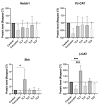Inhibition of Cancer Stem-like Cells by Curcumin and Other Polyphenol Derivatives in MDA-MB-231 TNBC Cells
- PMID: 39000554
- PMCID: PMC11242520
- DOI: 10.3390/ijms25137446
Inhibition of Cancer Stem-like Cells by Curcumin and Other Polyphenol Derivatives in MDA-MB-231 TNBC Cells
Abstract
Triple-negative breast cancer (TNBC) accounts for 15% of all breast cancers and is highly aggressive. Despite an initial positive response to chemotherapy, most patients experience rapid disease progression leading to relapse and metastasis. This is attributed to the presence of breast cancer stem cells (BCSCs) within the tumor, which are characterized by self-renewal, pluripotency, and resistance mechanisms. Targeting BCSCs has become critical as conventional therapies fail to eradicate them due to a lack of specific targets. Curcumin, a polyphenol derived from turmeric (Curcuma longa), exhibits anticancer effects against breast cancer cells and BCSCs. The use of curcumin derivatives has been suggested as an approach to overcome the bioavailability and solubility problems of curcumin in humans, thereby increasing its anticancer effects. The aim of this study was to evaluate the cellular and molecular effects of six synthetic compounds derived from the natural polyphenol epigallocatechin gallate (EGCG) (TL1, TL2) and curcumin derivatives (TL3, TL4, TL5, and TL6) on a TNBC mesenchymal stem-like cell line. The activity of the compounds against BCSCs was also determined by a mammosphere inhibition assay and studying different BCSC markers by Western blotting. Finally, a drug combination assay was performed with the most promising compounds to evaluate their potential synergistic effects with the chemotherapeutic agents doxorubicin, cisplatin, and paclitaxel. The results showed that compounds exhibited specific cytotoxicity against the TNBC cell line and BCSCs. Interestingly, the combination of the curcumin derivative TL3 with doxorubicin and cisplatin displayed a synergistic effect in TNBC cells.
Keywords: cancer stem cells; curcumin; polyphenols; triple-negative breast cancer.
Conflict of interest statement
The authors declare no conflicts of interest.
Figures







References
MeSH terms
Substances
LinkOut - more resources
Full Text Sources
Miscellaneous

